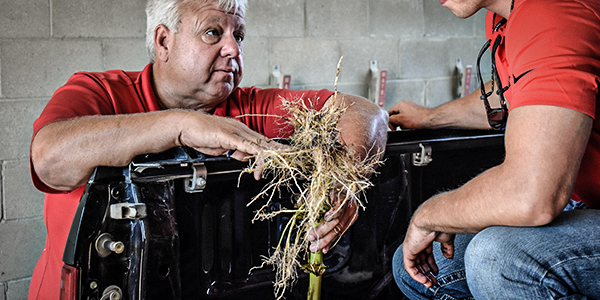AGRONOMICSUPPORT
YOU CAN TAKETO THE FIELD
Crop Progress in the Western and Central Corn Belt
Farmers were able to get the 2020 crop in the ground in a timely fashion thanks to good soil conditions across most of the western Corn Belt. May was a little cooler and drier across the area though, and this led to some reduced stands and a slower early development. Corn plants stayed on the yellow side a little longer than we like to see but with the recent heat and rains it is really starting to come around. We are transitioning into scouting for in-season pests in soybeans, like bean leaf beetles, thistle caterpillars, and soybean gall midge. Most alfalfa has been through first cutting, and we saw some reduced production in areas due to alfalfa weevils. Growers will need to scout for leafhoppers in the next few weeks before they can affect the second cutting.
We were able to get almost all our planned plots in the ground, so we should be able to generate some good, local data for growers this fall. Below are some brief updates from the Technical Team Agronomists in the field.
Northeast Nebraska – Jamie Kathol
We have recently gotten the heat and sunlight the crops in this area have been needing. This has made things grow rapidly, even the weeds. Corn post-emerge herbicide applications will be wrapping up in the next week and many are starting to apply post-emerge herbicide applications to soybeans. Sidedress and topdress applications of nitrogen on corn are in full swing. There was been some replant of both corn and soybeans in the area, mostly due to stand issues as a result of high residue from last year.
Southeast and East Central Nebraska – Mark Grundmayer
April planting progress was amazing, then May came into the picture. Cloudy, below average temps for the majority of the month and a few nights that saw low temperatures around freezing slowed crop growth, but all of east central and southeast Nebraska benefitted from rains over Memorial Day weekend. Soybean planting was basically wrapped in May as well, and in some areas the cold temps and rain reduced stands causing some replanting. No-till corn has had some stand uniformity issues, this can be related back to some side-wall compaction and the cool weather in May. Overall, the crop has made some very good progress thanks to the 90+ degree heat the first 8 days of June.
Central Nebraska – Scott Dugan
Crop Stage: Corn V4-V6; Soybeans V2-V4
Central Nebraska has been fortunate, in terms of weather, for most of the early growing season. Conditions were almost ideal from April 20th – May 7th and a lot of planting (corn & soybeans) of acres were completed in that time frame. Crop development looked tremendous up to this point, we had some great looking root structures and there was little evidence of insect pressures or seedling diseases. Since May 8th we have had 2 big events that have warranted replant or reduced stands to less than ideal populations.
First event was a 4-day cold spell starting on May 10th where nighttime temps were as low as 26 degrees. The early planted soybeans acres took the biggest hit and we did see some minor replant needed where we saw populations drop below thresholds. Although corn tissue that was above ground became chlorotic due to the damaging freeze the growing point remained below ground and new tissue was able to emerge a week later. Imbibitional chilling was observed in corn acres that were planted towards the end of the 1st week of May and resulted in some seedlings “leafing out” below ground.
The second event was from May 21st-May 25th, rainfall accumulating to 15” in some of areas caused flooding and washed out rows on hillsides that resulted in replant acres for both crops. The area was able to get most replants done by the end of the first week of June and we are seeing those acres emerge quickly with the 90-degree temps that we recently went through.
Insects – Wireworms and seedcorn maggots were reported in higher numbers this year causing some stand loss in both crops. Black cutworm and corn rootworm larvae will be the insects to watch out for in the upcoming days.
Diseases- Seedling diseases have been identified, but not to the degree we have seen in recent years.
Despite our 2 setbacks, crops look to be off to a great start. We have accumulated some steady GDUs and had some good weeks of sunshine that has resulted in one of the better starts to a growing season that we have seen in the past 3-4 years. Hopefully the weather with be more favorable again in the upcoming weeks as the crops will began their aggressive vegetational stages from V6 to VT.
Please contact your local Team 40 SAM if you have any questions or if we can be of any assistance to you during the rest of the 2020 growing season.
Western Nebraska and Colorado – Matt Teply
Planting in most of the region is all but wrapped up. A few dryland acres of corn and grain sorghum going in the ground yet. But, 2020 planting for the most part is done. Some of the earliest planted corn, late part of the week of April 13th, has reached the V6 to V7 growth stage. Much of the corn crop is in the V4 to V5 growth stage. The crop looks good considering how cool we were most of late April and May. Recent heat in June has greatly helped both corn and soybean acres. The soybean acres vary in vegetative stage greatly depending on planting date. Grain sorghum acres have just started to be planted in the last two weeks. For the most part planting conditions were better than last year. Yet, still cooler than average and has delayed vegetative growth of all crops. Looking forward to a warmer June and heat units.
Northwest Iowa – Jeff Morey
Since finishing most of the corn and soybean planting in NW IA around May 10th, the weather has been quite a challenge. We slowed things down dramatically with a cold snap May 4th – 13th and then several heavy rainfall events have drowned out portions of fields to the eastern half of NW IA. Then we ended the month of May with 10-12 days of cloudy conditions, but the early June heat had crops in the western half of NW IA showing signs of drought stress. Despite some of the best planting conditions in the last 4 years, many of those weather stresses caused both the corn and soybean crop to emerge and develop unevenly. Most of the corn is at V3-V5 stage and the soybeans are in the VC-V2 stage. The sun, heat, and latest rainfall event should help most of the crop to start improving quite rapidly.
West Central Iowa – Greg Peters
Recent heat has finally pushed the crop along in west central Iowa. Corn is up to the V6 stage and fields look ok from the road. When spring began many producers thought this will be one of the easiest planting seasons we have ever had, but as the season has progressed many challenges have been dealt with. Compaction, dryness, heavy residues and cold temperatures have led to plants stands that are lower than expected and may limit the upper end yield potential because many stands are off 20 to 30 percent. We have also been dealing with herbicides affecting stands because the seeds were in the ground long enough that safeners ran out resulting in stunted plants or reduced plant stands. We have also started to see more ammonia burn from spring applications of nitrogen.
Rainfall is what we needed to help reduce the effect of what we have been seeing in the field as much of the areas has minimal rains all spring. Recent rains have brought some relief for some in the area with rainfall amounts from .2 tenths to 4 inches and these amounts were spotty. We will still be rain dependent as the season progresses.
Soybeans have had some of the same experiences as corn but stands look good overall. Plants are going into the fourth trifoliate.
Southwest Iowa and Northwest Missouri – Mitch Barlow
In general things in SW IA and NW MO look very good as far as corn is concerned. With the recent heat we have been able to catch up on GDD’s that were lost in a cool - dry May. Most corn in SW IA is somewhere around V7 – V8 and is close to shading the rows. NW MO is slightly behind that growth stage due to a later planting window however still looks good to very good.
Soybeans also look good to very good. There are a few stand issues, however, this is by far the extreme and not the norm. NW MO has seen a delay in soybean planting due to an abundance of moisture. None the less, they are getting close to finishing up. We are seeing some painted lady butterflies in some of the early planted soybeans and we will need to continue to scout for thistle caterpillars, to determine whether to put an insecticide with our post applied herbicide.
Download a copy of this technical bulletin here: Crop Progress in the Western and Central Corn Belt






Area Agronomy Manager